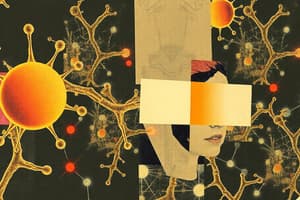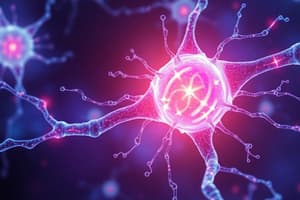Podcast
Questions and Answers
What is the primary function of cell signal transduction?
What is the primary function of cell signal transduction?
- To eliminate waste products from the cell.
- To produce energy for cellular functions.
- To facilitate communication and regulation of biological processes. (correct)
- To maintain cell structure and integrity.
Which type of signaling involves communication between cells?
Which type of signaling involves communication between cells?
- Intracellular signaling
- Translational signaling
- Intercellular signaling (correct)
- Transcriptional signaling
What role do ligands play in cell signaling?
What role do ligands play in cell signaling?
- They degrade signaling molecules after reception.
- They bind to specific receptors to trigger a biological response. (correct)
- They transport signals through the cytoplasm.
- They are proteins that catalyze reactions.
Which of the following is NOT a step in intercellular signaling?
Which of the following is NOT a step in intercellular signaling?
In cell signaling, what does a receptor typically do?
In cell signaling, what does a receptor typically do?
Which of the following describes the term 'second messenger'?
Which of the following describes the term 'second messenger'?
What characterizes a specific ligand's interaction with a receptor?
What characterizes a specific ligand's interaction with a receptor?
What is the primary action that occurs after a ligand binds to a receptor?
What is the primary action that occurs after a ligand binds to a receptor?
Which type of signaling involves cells communicating through diffuse signals acting on nearby cells?
Which type of signaling involves cells communicating through diffuse signals acting on nearby cells?
What is a key characteristic of endocrine signaling?
What is a key characteristic of endocrine signaling?
Which form of signaling is characterized by a cell producing a signal that binds to its own receptors?
Which form of signaling is characterized by a cell producing a signal that binds to its own receptors?
In which form of signaling do small molecules pass through water-filled channels between adjacent cells?
In which form of signaling do small molecules pass through water-filled channels between adjacent cells?
What role do protein kinases play in cellular signaling?
What role do protein kinases play in cellular signaling?
Which type of receptors are located in the cytoplasm or nucleus?
Which type of receptors are located in the cytoplasm or nucleus?
What is a common feature of all types of chemical cell signaling?
What is a common feature of all types of chemical cell signaling?
Which of the following statements is false regarding autocrine signaling?
Which of the following statements is false regarding autocrine signaling?
What type of receptors respond to hydrophobic ligands that cross the plasma membrane?
What type of receptors respond to hydrophobic ligands that cross the plasma membrane?
Which statement accurately describes cell-surface receptors?
Which statement accurately describes cell-surface receptors?
What do ion channel-linked receptors do upon ligand binding?
What do ion channel-linked receptors do upon ligand binding?
Which example is associated with G-protein-linked receptors?
Which example is associated with G-protein-linked receptors?
What is the primary function of enzyme-linked receptors?
What is the primary function of enzyme-linked receptors?
Which phrase best describes second messengers in intracellular signaling?
Which phrase best describes second messengers in intracellular signaling?
What role does phosphorylation play in cellular signaling?
What role does phosphorylation play in cellular signaling?
What happens when G-proteins are activated upon ligand binding?
What happens when G-proteins are activated upon ligand binding?
Which receptor is primarily involved in the response to insulin?
Which receptor is primarily involved in the response to insulin?
Flashcards are hidden until you start studying
Study Notes
Cell Signal Transduction
- The process by which cells respond to external chemical signals.
- Crucial for cell communication and regulation of biological processes.
Types of Cell Signalling
- Intercellular Signalling: Communication between cells.
- Intracellular Signalling: Signalling chains within the cell, responding to both extracellular and intracellular stimuli.
Intercellular Signalling in Eukaryotic Cells
- Coordinates vital functions, maintaining and ensuring the function of specialized tissues and organs.
- Involved in cell growth, division, motility, and morphology.
Signalling Receptors
- Protein molecules in or on target cells that bind to ligands.
- Trigger a cellular response.
Ligands
- Molecules that attach to specific receptors on a cell.
- Act as "keys" that bind to "locks" (receptors) on the cell.
- Each ligand has a specific receptor.
Receptors
- Essential for cell communication and response.
Steps of Intercellular Signalling
- Formation: External trigger causes the production or release of signaling molecules, like hormones, from specialized cells.
- Signal Transport: Signals travel to the target cell, often through circulation or diffusion, sometimes using carrier proteins.
- Signal Reception: Target cell receives the signal through specific receptors, initiating intracellular signaling pathways.
- Signal Processing: Signal is converted into a biochemical response within the target cell, leading to specific cellular actions.
Stages of Cellular Signal Transduction
- Reception: Cells detect chemical signals through receptors.
- Transduction: Signal is converted into an internal response.
- Response: Cell performs a specific action in response to the signal.
Signal Pathways
- Often involve a series of steps with relay molecules.
- Action: Could include changes in gene expression, enzyme activity, or cell metabolism.
Common Events in Intracellular Signalling
- Phosphorylation: Adding a phosphate group to a protein by an enzyme called kinase, which can either activate or deactivate the protein.
- Second Messengers: Intracellular, diffusible small molecules and ions quickly synthesized or released in response to signals from receptors. Second messengers alter the activity of target signaling proteins.
Second Messengers
- Cyclic Nucleotides: Cyclic AMP (cAMP) and cyclic GMP (cGMP)
- Lipid Messengers: Originate within cell membranes, including inositol trisphosphate (IP3).
- Gases: Can signal throughout the cell and even to neighboring cells, like nitric oxide (NO), carbon monoxide (CO), and hydrogen sulfide (H2S).
- Ions: Signal within and between cellular compartments, like Calcium (Ca), Na, and K.
cGMP (Cyclic guanosine monophosphate)
- Structure: Nucleotide with a sugar, guanine base, and a single phosphate group in a cyclic bond.
- Function: Acts as a second messenger in processes like:
- Smooth muscle contraction.
- Phototransduction in the eye.
- Blood vessel dilation.
Forms of Chemical Cell Signalling
- Paracrine Signalling: Signals act locally between nearby cells. Signals move by diffusion through the extracellular matrix. Elicit quick, short-lasting responses.
- Endocrine Signalling: Signals originate from distant endocrine cells located in endocrine glands. They produce slower, longer-lasting effects. Hormones are released by glands into the bloodstream and travel long distances to target cells.
- Autocrine Signalling: Signals produced and responded to by the same cell. Signaling cell releases a signal that binds to its own receptors.
- Direct Signalling across Gap Junctions: Direct communication between neighboring cells through water-filled channels. Gap junctions in animals, plasmodesmata in plants. Small molecules like calcium ions (Ca2+) can pass through; larger molecules cannot.
Types of Receptors
- Internal Receptors: Found in the cytoplasm or nucleus. Respond to hydrophobic ligands that cross the plasma membrane. Regulate gene expression by binding to DNA after a ligand-induced conformational change.
- Cell-Surface Receptors: (Transmembrane receptors) Bind external ligands without the ligands entering the cell. Specific to cell types and convert extracellular signals into intracellular actions.
Types of Cell-Surface Receptors
- Ion Channel-Linked Receptors: Open a channel through the membrane when a ligand binds, allowing specific ions to pass through and alter the cell's activity. E.g. acetylcholine (nicotine receptor).
- G-Protein-Linked Receptors: Activate G-proteins upon ligand binding, which then interact with other membrane proteins to propagate the signal. G-proteins switch between active and inactive states to regulate cellular responses. E.g. Dopamine.
- Enzyme-Linked Receptors: Have an intracellular domain that acts as an enzyme or associates with an enzyme. Ligand binding activates the enzyme, triggering a cascade of cellular events. E.g. insulin receptor.
Studying That Suits You
Use AI to generate personalized quizzes and flashcards to suit your learning preferences.




